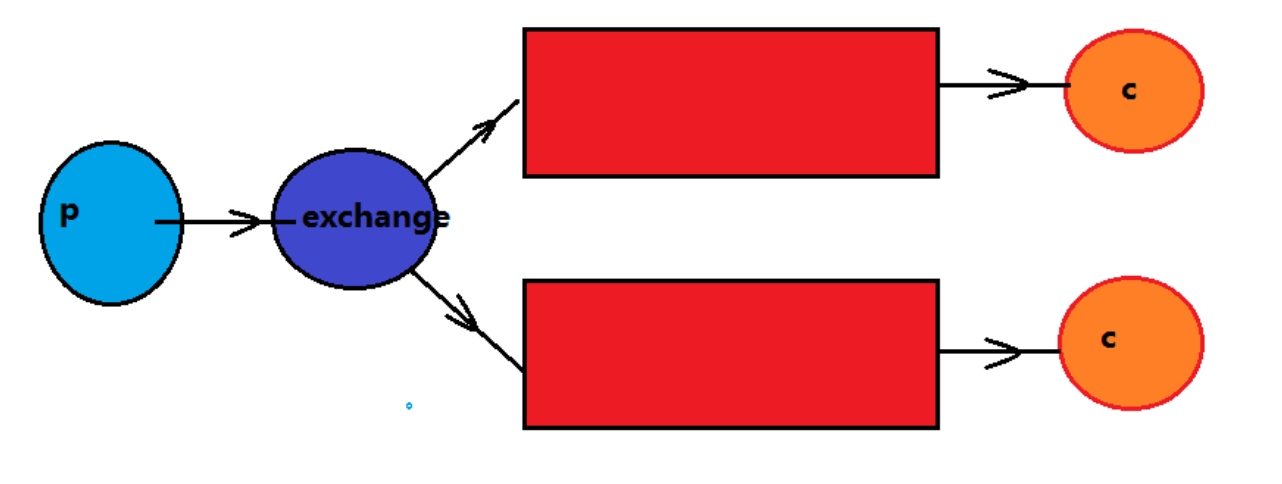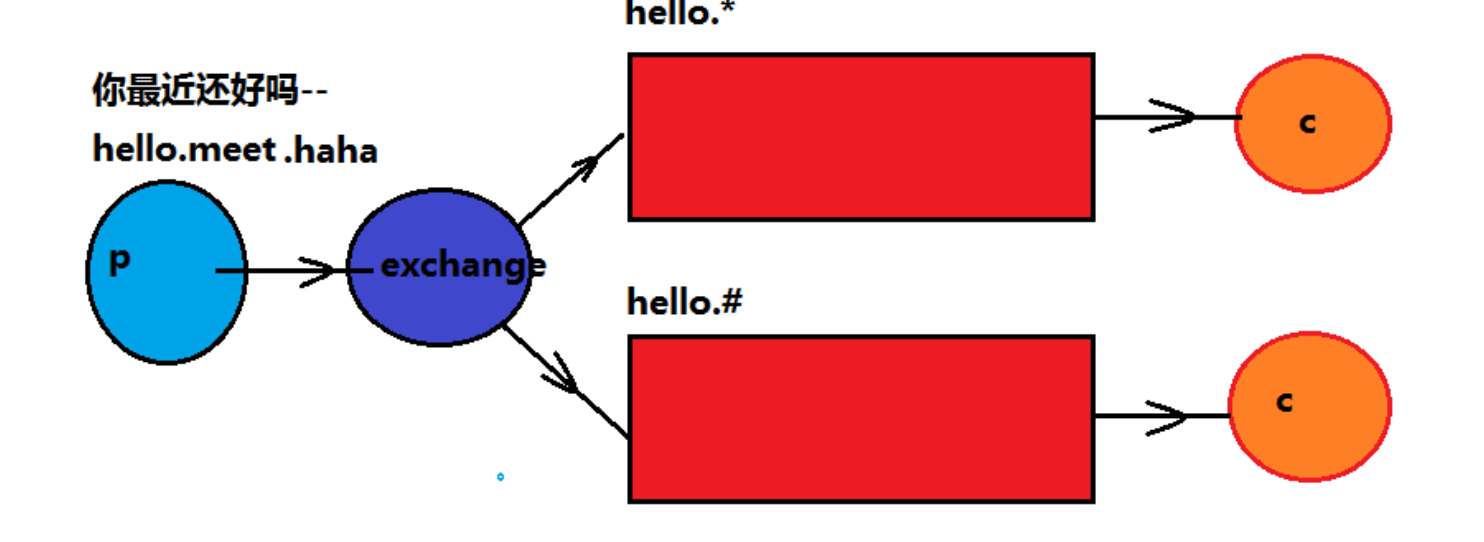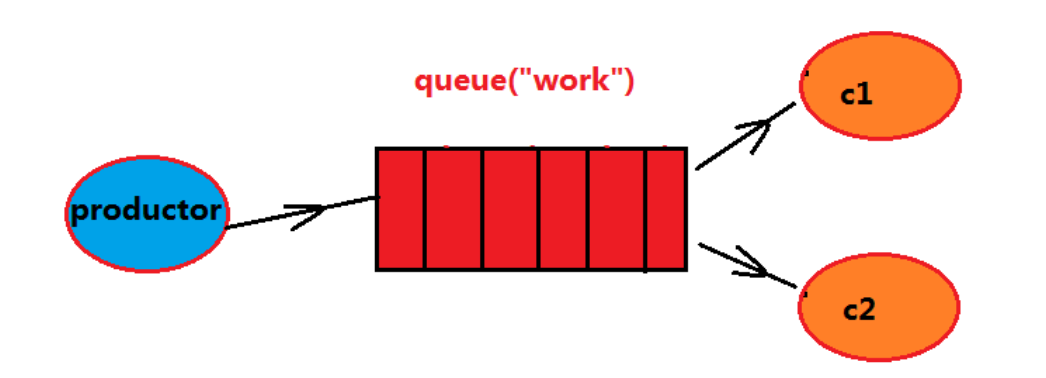Rabbitmq的五種模式和案例
阿新 • • 發佈:2018-12-25
1.simple模式

訊息生產者p將訊息放入佇列
消費者監聽佇列,如果佇列中有訊息,就消費掉,訊息被拿走後,自動從佇列刪除
(隱患,訊息可能沒有被消費者正確處理,已經消失了,無法恢復)
應用場景:聊天室
案例:
1>.首先準備依賴
<dependency>
<groupId>org.springframework.boot</groupId>
<artifactId>spring-boot-starter-amqp</artifactId>
</dependency>public class SimpleTest { //模擬生產者將訊息放入佇列 @Test public void send() throws Exception{ /*1 建立連線工廠 * 2 配置共創config * 3 獲取連線 * 4獲取通道 * 5 從通道宣告queue * 6 傳送訊息 * 7 釋放資源 */ ConnectionFactory factory=new ConnectionFactory(); factory.setHost("106.23.34.56"); factory.setPort(5672); factory.setVirtualHost("/tb"); factory.setUsername("admin"); factory.setPassword("123456"); //從工廠獲取連線 Connection conn=factory.newConnection(); //從連接獲取通道 Channel chan=conn.createChannel(); //利用channel宣告第一個佇列 chan.queueDeclare("simple", false, false, false, null); //queue String型別,表示宣告的queue對列的名字 //durable Boolean型別,表示是否持久化 //exclusive Boolean型別:當前宣告的queue是否專注;true當前連線建立的 //任何channle都可以連線這個queue,false,新的channel不可使用 //autoDelete Boolean型別:在最後連線使用完成後,是否刪除佇列,false //arguments Map型別,其他宣告引數 //傳送訊息 String msg="helloworld,nihaoa"; chan.basicPublish("", "simple", null, msg.getBytes()); //exchange String型別,交換機名稱,簡單模式使用預設交換"" //routingkey String型別,當前的訊息繫結的routingkey,簡單模式下,與佇列同名即可 //props BasicProperties型別,訊息的屬性欄位物件,例如BasicProperties //可以設定一個deliveryMode的值0 持久化,1 表示不持久化,durable配合使用 //body byte[] :訊息字串的byte陣列 } //模擬消費端 @Test public void receive() throws Exception{
ConnectionFactory factory=new ConnectionFactory();
factory.setHost("106.23.34.56");
factory.setPort(5672);
factory.setVirtualHost("/tb");
factory.setUsername("admin");
factory.setPassword("123456");
//從工廠獲取連線
2.work模式
多個消費者同時監聽同一個佇列,訊息如何被消費?
C1,C2共同爭搶當前訊息佇列的內容,誰先拿到訊息,誰來負責消費
應用場景:紅包;大型專案中的資源排程過程(直接由最空閒的系統爭搶到資源處理任務)
案例:
1>首先寫一個工具類
public class ConnectionUtil { public static Connection getConn(){ try{ ConnectionFactory factory=new ConnectionFactory(); factory.setHost("106.33.44.179"); factory.setPort(5672); factory.setVirtualHost("/tb"); factory.setUsername("admin"); factory.setPassword("123456"); //從工廠獲取連線 Connection conn=factory.newConnection(); return conn; }catch(Exception e){ System.out.println(e.getMessage()); return null; } } }
2>寫test類
public class WorkTest {
@Test
public void send() throws Exception{
//獲取連線
Connection conn = ConnectionUtil.getConn();
Channel chan = conn.createChannel();
//宣告佇列
chan.queueDeclare("work", false, false, false, null);
for(int i=0;i<100;i++){
String msg="1712,hello:"+i+"message";
chan.basicPublish("", "work", null, msg.getBytes());
System.out.println("第"+i+"條資訊已經發送");
}
chan.close();
conn.close();
}
@Test
public void receive1() throws Exception{
//獲取連線,獲取通道
Connection conn = ConnectionUtil.getConn();
Channel chan = conn.createChannel();
chan.queueDeclare("work", false, false, false, null);
//同一時刻伺服器只發送一條訊息給同一消費者,消費者空閒,才傳送一條
chan.basicQos(1);
//定義消費者
QueueingConsumer consumer=new QueueingConsumer(chan);
//繫結佇列和消費者的關係
//queue
//autoAck:訊息被消費後,是否自動確認回執,如果false,不自動需要手動在
//完成訊息消費後進行回執確認,channel.ack,channel.nack
//callback
//chan.basicConsume(queue, autoAck, callback)
chan.basicConsume("work", false, consumer);
//監聽
while(true){
Delivery delivery=consumer.nextDelivery();
byte[] result = delivery.getBody();
String msg=new String(result);
System.out.println("接受到:"+msg);
Thread.sleep(50);
//返回伺服器,回執
chan.basicAck(delivery.getEnvelope().getDeliveryTag(), false);
}
}
@Test
public void receive2() throws Exception{
//獲取連線,獲取通道
Connection conn = ConnectionUtil.getConn();
Channel chan = conn.createChannel();
chan.queueDeclare("work", false, false, false, null);
//同一時刻伺服器只發送一條訊息給同一消費者,消費者空閒,才傳送一條
chan.basicQos(1);
//定義消費者
QueueingConsumer consumer=new QueueingConsumer(chan);
//繫結佇列和消費者的關係
//queue
//autoAck:訊息被消費後,是否自動確認回執,如果false,不自動需要手動在
//完成訊息消費後進行回執確認,channel.ack,channel.nack
//callback
//chan.basicConsume(queue, autoAck, callback)
chan.basicConsume("work", false, consumer);
//監聽
while(true){
Delivery delivery=consumer.nextDelivery();
byte[] result = delivery.getBody();
String msg=new String(result);
System.out.println("接受到:"+msg);
Thread.sleep(150);
//返回伺服器,回執
chan.basicAck(delivery.getEnvelope().getDeliveryTag(), false);
}
}
}
3 publish/fanout釋出訂閱

生產者將訊息交給交換機
有交換機根據釋出訂閱的模式設定將訊息同步到所有的繫結佇列中;
後端的消費者都能拿到訊息
應用場景:郵件群發,群聊天,廣告
案例:
public class FanoutTest {
//交換機,有型別,釋出訂閱:fanout
//路由模式:direct
//主題模式:topic
@Test
public void send() throws Exception {
//獲取連線
Connection conn = ConnectionUtil.getConn();
Channel chan = conn.createChannel();
//宣告交換機
//引數意義,1 交換機名稱,2 型別:fanout,direct,topic
chan.exchangeDeclare("fanoutEx", "fanout");
//傳送訊息
for(int i=0;i<100;i++){
String msg="1712 hello:"+i+"msg";
chan.basicPublish("fanoutEx", "", null, msg.getBytes());
System.out.println("第"+i+"條資訊已經發送");
}
}
@Test
public void receiv01() throws Exception{
//獲取連線
Connection conn = ConnectionUtil.getConn();
Channel chan = conn.createChannel();
//生命佇列
chan.queueDeclare("fanout01", false, false, false, null);
//宣告交換機
chan.exchangeDeclare("fanoutEx", "fanout");
//繫結佇列到交換機
//引數 1 佇列名稱,2 交換機名稱 3 路由key
chan.queueBind("fanout01", "fanoutEx", "");
chan.basicQos(1);
//定義消費者
QueueingConsumer consumer=new QueueingConsumer(chan);
//消費者與佇列繫結
chan.basicConsume("fanout01",false, consumer);
while(true){
Delivery delivery= consumer.nextDelivery();
System.out.println("一號消費者接收到"+
new String(delivery.getBody()));
chan.basicAck(delivery.getEnvelope().
getDeliveryTag(), false);
}
}
@Test
public void receiv02() throws Exception{
//獲取連線
Connection conn = ConnectionUtil.getConn();
Channel chan = conn.createChannel();
//生命佇列
chan.queueDeclare("fanout02", false, false, false, null);
//宣告交換機
chan.exchangeDeclare("fanoutEx", "fanout");
//繫結佇列到交換機
//引數 1 佇列名稱,2 交換機名稱 3 路由key
chan.queueBind("fanout02", "fanoutEx", "");
chan.basicQos(1);
//定義消費者
QueueingConsumer consumer=new QueueingConsumer(chan);
//消費者與佇列繫結
chan.basicConsume("fanout02",false, consumer);
while(true){
Delivery delivery= consumer.nextDelivery();
System.out.println("二號消費者接收到"+new String(delivery.getBody()));
chan.basicAck(delivery.getEnvelope().getDeliveryTag(), false);
}
}
}
4 routing路由模式

生產者傳送訊息到交換機,同時繫結一個路由Key,交換機根據路由key對下游繫結的佇列進行路
由key的判斷,滿足路由key的佇列才會接收到訊息,消費者消費訊息
應用場景: 專案中的error報錯
案例:
public class RoutingTopicTest {
@Test
public void routingSend() throws Exception{
//獲取連線
Connection conn = ConnectionUtil.getConn();
Channel chan = conn.createChannel();
//宣告交換機
//引數意義,1 交換機名稱,2 型別:fanout,direct,topic
chan.exchangeDeclare("directEx", "direct");
//傳送訊息
String msg="路由模式的訊息";
chan.basicPublish("directEx", "jt1713",
null, msg.getBytes());
}
@Test
public void routingRec01() throws Exception{
System.out.println("一號消費者等待接收訊息");
//獲取連線
Connection conn = ConnectionUtil.getConn();
Channel chan = conn.createChannel();
//宣告佇列
chan.queueDeclare("direct01", false, false, false, null);
//宣告交換機
chan.exchangeDeclare("directEx", "direct");
//繫結佇列到交換機
//引數 1 佇列名稱,2 交換機名稱 3 路由key
chan.queueBind("direct01", "directEx", "jt1712");
chan.basicQos(1);
//定義消費者
QueueingConsumer consumer=new QueueingConsumer(chan);
//消費者與佇列繫結
chan.basicConsume("direct01",false, consumer);
while(true){
Delivery delivery= consumer.nextDelivery();
System.out.println("一號消費者接收到"+
new String(delivery.getBody()));
chan.basicAck(delivery.getEnvelope().
getDeliveryTag(), false);
}
}
@Test
public void routingRec02() throws Exception{
System.out.println("二號消費者等待接收訊息");
//獲取連線
Connection conn = ConnectionUtil.getConn();
Channel chan = conn.createChannel();
//宣告佇列
chan.queueDeclare("direct02", false, false, false, null);
//宣告交換機
chan.exchangeDeclare("directEx", "direct");
//繫結佇列到交換機
//引數 1 佇列名稱,2 交換機名稱 3 路由key
chan.queueBind("direct02", "directEx", "jt1711");
chan.basicQos(1);
//定義消費者
QueueingConsumer consumer=new QueueingConsumer(chan);
//消費者與佇列繫結
chan.basicConsume("direct02",false, consumer);
while(true){
Delivery delivery= consumer.nextDelivery();
System.out.println("二號消費者接收到"+
new String(delivery.getBody()));
chan.basicAck(delivery.getEnvelope().
getDeliveryTag(), false);
}
}
}5 topic主題模式

*號代表單個詞語
#代表多個詞語
其他的內容與routing路由模式一致
案例:
public class RoutingTopicTest {
@Test
public void routingRec02() throws Exception{
System.out.println("二號消費者等待接收訊息");
//獲取連線
Connection conn = ConnectionUtil.getConn();
Channel chan = conn.createChannel();
//宣告佇列
chan.queueDeclare("direct02", false, false, false, null);
//宣告交換機
chan.exchangeDeclare("directEx", "direct");
//繫結佇列到交換機
//引數 1 佇列名稱,2 交換機名稱 3 路由key
chan.queueBind("direct02", "directEx", "jt1711");
chan.basicQos(1);
//定義消費者
QueueingConsumer consumer=new QueueingConsumer(chan);
//消費者與佇列繫結
chan.basicConsume("direct02",false, consumer);
while(true){
Delivery delivery= consumer.nextDelivery();
System.out.println("二號消費者接收到"+
new String(delivery.getBody()));
chan.basicAck(delivery.getEnvelope().
getDeliveryTag(), false);
}
}
@Test
public void topicSend() throws Exception{
//獲取連線
Connection conn = ConnectionUtil.getConn();
Channel chan = conn.createChannel();
//宣告交換機
//引數意義,1 交換機名稱,2 型別:fanout,direct,topic
chan.exchangeDeclare("topicEx", "topic");
//傳送訊息
String msg="主題模式的訊息";
chan.basicPublish("topicEx", "jt1712.add.update",
null, msg.getBytes());
}
@Test
public void topicRec01() throws Exception{
System.out.println("一號消費者等待接收訊息");
//獲取連線
Connection conn = ConnectionUtil.getConn();
Channel chan = conn.createChannel();
//宣告佇列
chan.queueDeclare("topic01", false, false, false, null);
//宣告交換機
chan.exchangeDeclare("topicEx", "topic");
//繫結佇列到交換機
//引數 1 佇列名稱,2 交換機名稱 3 路由key
chan.queueBind("topic01", "topicEx", "jt1712");
chan.basicQos(1);
//定義消費者
QueueingConsumer consumer=new QueueingConsumer(chan);
//消費者與佇列繫結
chan.basicConsume("topic01",false, consumer);
while(true){
Delivery delivery= consumer.nextDelivery();
System.out.println("一號消費者接收到"+
new String(delivery.getBody()));
chan.basicAck(delivery.getEnvelope().
getDeliveryTag(), false);
}
}
@Test
public void topicRec02() throws Exception{
System.out.println("二號消費者等待接收訊息");
//獲取連線
Connection conn = ConnectionUtil.getConn();
Channel chan = conn.createChannel();
//宣告佇列
chan.queueDeclare("topic02", false, false, false, null);
//宣告交換機
chan.exchangeDeclare("topicEx", "topic");
//繫結佇列到交換機
//引數 1 佇列名稱,2 交換機名稱 3 路由key
chan.queueBind("topic02", "topicEx", "jt1712.#");
chan.basicQos(1);
//定義消費者
QueueingConsumer consumer=new QueueingConsumer(chan);
//消費者與佇列繫結
chan.basicConsume("topic02",false, consumer);
while(true){
Delivery delivery= consumer.nextDelivery();
System.out.println("二號消費者接收到"+
new String(delivery.getBody()));
chan.basicAck(delivery.getEnvelope().
getDeliveryTag(), false);
}
}
}

